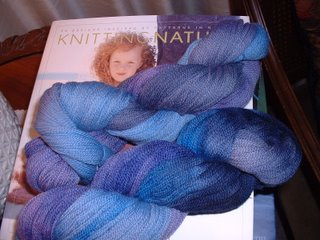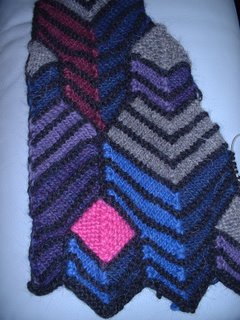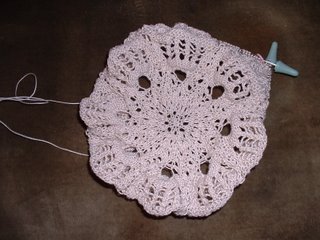 The Swallowtail Shawl from Interweave Knits Fall 2006 issue appears to be everywhere in blogdom. I had decided to make this short, lacy shawl when I first saw it a couple of months ago, before I knew about the knitalong blogs. Yes, there's more than one!
The Swallowtail Shawl from Interweave Knits Fall 2006 issue appears to be everywhere in blogdom. I had decided to make this short, lacy shawl when I first saw it a couple of months ago, before I knew about the knitalong blogs. Yes, there's more than one!
I'm glad I waited to find just the right fiber.
This yarn is Kaalund's Enchante, a 100% silk laceweight. It's a superfine laceweight, but not cobweb. And the colors! I'm using Silky Oak for the first section - a subtly variegated peach and gold - and I'll finish it off with Nectarine (the slightly more peachy-red yarn ball in the photo). I'm hoping it will look something like a sunset, but the proof will be in the lace.
So far, my only qualm about this yarn is that it doesn't "give" or stretch, so knitting the p5tog's in the Lily of the Valley border is a challenge. I choose to knit these nupps with a small crochet hook. The shawl is on a size 4 circular, and the hook is #5 steel.
What works for me is sliding the hook from right to left under five stitches on the lefthand circular needle, hooking the working yarn and pulling a loop through the five stitches. Then I slide the five stitches I just worked off the lefthand needle and put the new loop on the righthand needle.
 Here's another finished Herbert Niebling doily! This one is from a pattern published in Lena magazine (Germany). This September 2006 issue also contains a lovely Niebling tablecloth pattern.
Here's another finished Herbert Niebling doily! This one is from a pattern published in Lena magazine (Germany). This September 2006 issue also contains a lovely Niebling tablecloth pattern.
Many thanks to Courtney on the laceknitters list for the translation from German to English!
Also many thanks to Judy Gibson who researched and found the smaller doily was published previously in Kunsthakeln & Kunststricken, as part of a series, and called "Strick & Shrick, Sonderheft No. 3." Judy notes that the designer Niebling is not credited in the previous publication.
I made the doily using size 0 needles and DMC Baroque thread. This thread is not my favorite, but it does block nicely. It doesn't have the silky sheen of DMC Cebelia thread. I would recommend Baroque for everyday items and Cebelia for heirlooms.
Some people have asked how I start a doily like this. I prefer the Emily Ocker start, something I learned a long time ago. Basically, make a loop of yarn around your finger, and then crochet the number of stitches needed to start the doily into it. Then, divide up the stitches onto DPNs and start knitting. When using fine thread, it sometimes takes me several tries! The DPNs have a tendency to flop around, so I support them on top of a pillow on my lap until I've knit a few rounds. After knitting a few inches of the pattern, I pull the tail of the thread to close up the center hole.
Another method for a circular start is Rosemarie's bellybutton start, which has become quite popular with lace knitters. This is similar to the I-cord start, which entails knitting a short length of I-cord with scrap yarn, then switching to the project thread to begin knitting your pattern. After knitting a few inches of your pattern, you can unravel the I-cord, weave the tail of the project thread through the first pattern row and pull the tail snugly to close the center hole.
Finishing is another story. I came across some very old German steel crochet hooks at a flea market a while back and bought about ten of them in various sizes. Some of these old hooks have sharper tips than most modern hooks I've seen. For me, a pointier tip is great for crocheting off a doily. This Niebling doily required slipping five stitches off my circular onto the crochet hook, then slip-stitching through all loops on the hook, leaving one stitch on the hook. Next, I chained 12 (ch12), then slipped five more knit stitches onto the crochet hook, continuing in this manner until all stitches were crocheted off.
To block, I rinsed the doily in cool water and rolled it in a towel to soak up excess moisture. I pinned out each ch12 to a a nice sharp point. I also measured the diameter all the way around to make sure the doily was round and even. A good blocking board is essential.
Sometimes I use spray starch or "sizing" to finish off a doily. I only do this after the doily is blocked and dry. This is fine for doilies that see occasional use and may be washed and blocked again. If a doily will be stored for a long time, I don't like to use starch which may yellow with age.
If you press a doily with spray starch, I suggest using a hot iron with steam, a dry doily, Niagara spray starch, and a white towel or pilowcase underneath on the ironing board (or you'll end up with a starchy ironing board pad). Personally, I prefer the texture of an unpressed doily.
Of course, there are many ways to to start and finish, but these are the things I've learned and have used with some success.
 September ... what happened to September? Okay, I've been neglectful, but now it's October and Fall has dropped beautiful colors all around me. What project to take on next? I've got several in mind, and a few were started in busy September.
September ... what happened to September? Okay, I've been neglectful, but now it's October and Fall has dropped beautiful colors all around me. What project to take on next? I've got several in mind, and a few were started in busy September.
Kristin Omdahl shared with me a few new patterns to spice up the fall and winter. I'm currently working on a luscious wrap in Paca de Seda yarn, 80% wool and 20% silk. This stuff is soft and drapey ... and very warm for the cool months ahead.
I went to the Knitting Nature trunk show at Greenwich Yarn in San Francisco and saw firsthand the fabulous sweaters featured in Nora Gaughan's book.  The Ogee Tunic is absolutely lovely, knit in a fine yarn with distinctive textural features that set Nora's patterns apart. The other sweater that I found elegant with tailored finishing is the Ram's Horn Jacket. I'd probably make it a bit longer for me.
The Ogee Tunic is absolutely lovely, knit in a fine yarn with distinctive textural features that set Nora's patterns apart. The other sweater that I found elegant with tailored finishing is the Ram's Horn Jacket. I'd probably make it a bit longer for me.
By the way, those two gorgeous skeins of laceweight wool pictured on top of the book are from Inspirations Yarn. Margaret hand dyes her yarn in small batches, and the colors are phenomenal. These two lovely skeins want to be something, but I'm not sure what yet. I've got about 840 yards.
I also began working on something I had been thinking about for a long time. The last pattern in the book Dazzling Knits by Patricia Werner is the Metropolis Coat.  The architectural design is mesmerizing. I had been storing up Classic Elite Montara and Cascade Pastaza for literally years, waiting for something to inspire me. If you haven't seen this book, it's filled with unique modular designs that build one upon the next, picking up stitches from the side of one module to add another. The Metropolis Coat and the Mola Jacket really caught my attention. I decided to stick with the purple-plum-blue tones for the Metropolis. I never would have guessed I would be using ALL my colors of this soft llama/wool blend to make one garment. (Montara and Pastaza are the same, both 50% llama and 50% wool, a somewhat chunky single.) The black lines throughout the pattern are the main color that improvise a stained glass look.
The architectural design is mesmerizing. I had been storing up Classic Elite Montara and Cascade Pastaza for literally years, waiting for something to inspire me. If you haven't seen this book, it's filled with unique modular designs that build one upon the next, picking up stitches from the side of one module to add another. The Metropolis Coat and the Mola Jacket really caught my attention. I decided to stick with the purple-plum-blue tones for the Metropolis. I never would have guessed I would be using ALL my colors of this soft llama/wool blend to make one garment. (Montara and Pastaza are the same, both 50% llama and 50% wool, a somewhat chunky single.) The black lines throughout the pattern are the main color that improvise a stained glass look.
Aside from knitting, work and family pulled me in various directions. It's not surprising that I couldn't pin myself to one project at a time. I also started this small Herbert Niebling doily from the September 2006 issue of the German magazine Lena, purchased from Martina's Bastel und Hobbykiste in Germany. Martina is a member of the Knitted Lace list, and she speaks English. Her website is mostly in German, but if you click on the British flag on the homepage, you'll find it's easier to navigate. The doily is worked in DMC Baroque cotton and size 0 needle. The cotton is not the nicest, with little sheen compared to the lovely DMC Cebelia that I used for the Lyra.
doily from the September 2006 issue of the German magazine Lena, purchased from Martina's Bastel und Hobbykiste in Germany. Martina is a member of the Knitted Lace list, and she speaks English. Her website is mostly in German, but if you click on the British flag on the homepage, you'll find it's easier to navigate. The doily is worked in DMC Baroque cotton and size 0 needle. The cotton is not the nicest, with little sheen compared to the lovely DMC Cebelia that I used for the Lyra.
Other cottons I've used are Opera and Manuela. Opera is shiny and smooth, made by Coats, and comes in a wide variety of colors and weights. You can order Opera from Yarn & Threads by Lisa. She has a good selection of colors and fast shipping.  (I am not affiliated.) Supposedly, Manuela thread has been discontinued, but you can still find it in some shops.
(I am not affiliated.) Supposedly, Manuela thread has been discontinued, but you can still find it in some shops.
Unfinished projects abound. It's a good thing I found this lovely faux leather box at Joann's last week. It holds a lot and fits nicely next to our sofa. When the lid opens up, it stays up, so I can sift through my knitty bits without too much trouble.






